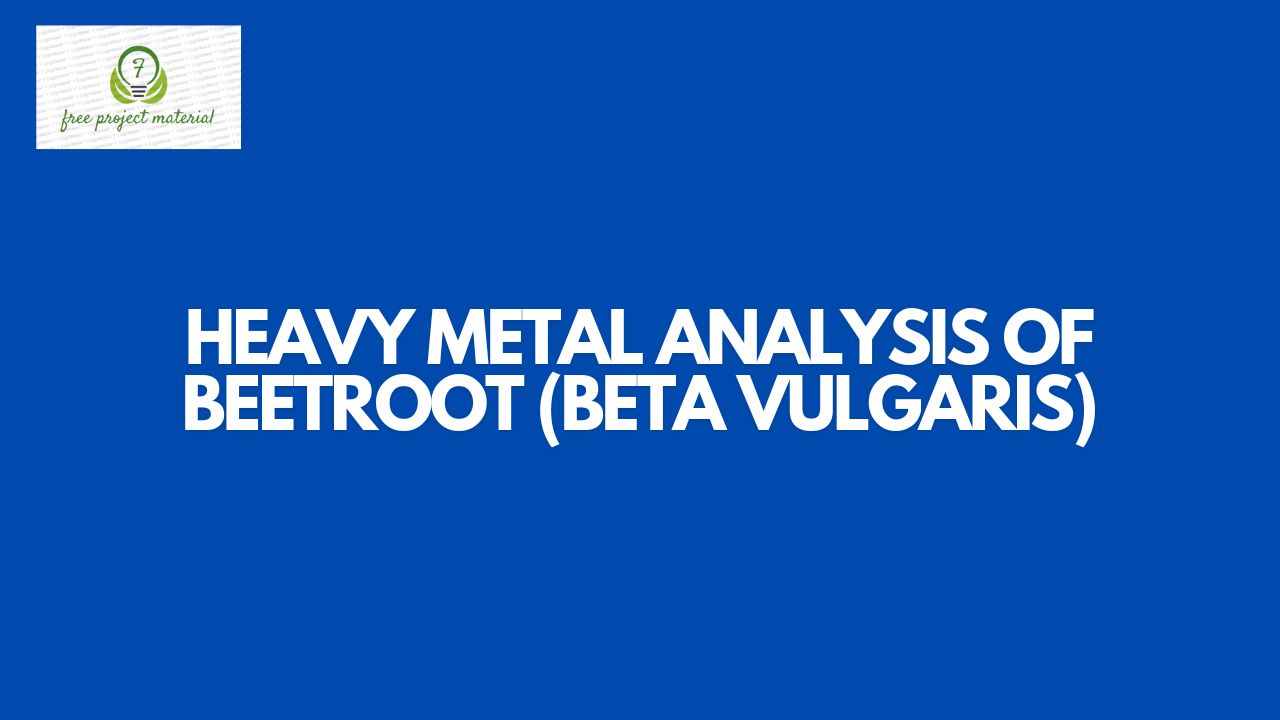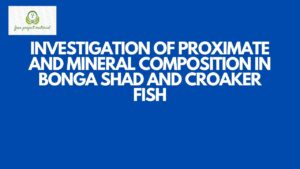ABSTRACT
This study was to determined the heavy metal composition of beetroot bought from Akpan Andem Market, Uyo. standard analytical method were employed in carry out the analysis. The result revealed the following; Pb (0.025±0.006 mg/kg), Cr (0.185±0.018 mg/kg), Cd (0.992±0.289 mg/kg) while As and Hg was not detected. The concentration of Pb, As, Hg and Cr were within the WHO permissible limit while Cd was above the WHO permissible limit. This implies that the consumption of this product may certainly result in cadmium poisoning as a result of the high concentration of cadmium in the beetroot sample. It is recommended that regular monitoring of these toxic metals in vegetables should be carried out to prevent heavy metal toxicity associated with the consumption of beetroot marketed in Akpan Andem market.
TABLE OF CONTENTS
Titel Page – – – – – – – – – i
Certification – – – – – – – – – ii
Dedication – – – – – – – – – iii
Acknowledgements – – – – – – – iv
Abstract – – – – – – – – – v
Table of Contents – – – – – – – – v
CHAPTER ONE: INTRODUCTION
1.1 Background of the Study – – – – – – 1
1.2 Aim and Objective of the Study – – – – – 4
1.2.1 Aim – – – – – – – – – 4
1.2.2 Objectives – – – – – – – – 4
1.3 Scope and Limitation of the Study:- – – – – 4
CHAPTER TWO: LITERATURE REVIEW
2.1 Botanical Classification of Beetroot – – – – 5
2.2 Description and Distribution of Beetroot – – – 6
2.3 Nutritional Value of Fresh Beetroots – – – – 8
2.4 Cultivation of Beetroot – – – – – – 9
2.5 Beetroot Product – – – – – – – 10
2.6 Medicinal Uses of Beetroot – – – – – 12
2.6.1 Health Benefit of Beetroot – – – – – 12
2.6.2 Pharmacological Activities of Beetroot – – – 14
CHAPTER THREE: MATERIALS AND METHODS
3.1 Materials and Reagents – – – – – – 17
3.2 Sample Collection and Preparation – – – – 17
3.3 Digestion of the Samples for Mineral Analysis – – 18
3.4 Analysis of Heavy Metals – – – – – 18
CHAPTER FOUR: RESULT AND DISCUSSION
4.1 Result – – – – – – – – – 20
4.2 Discussion – – – – – – – – 21
CHAPTER FIVE: CONCLUSION AND RECOMMENDATIONS
5.1 Conclusion – – – – – – – – 26
5.2 Recommendations – – – – – – – 26
References
CHAPTER ONE: INTRODUCTION
1.1 Background of the Study
Herbs are plants with savory or aromatic properties that are used for flavoring and garnishing food, in medicine, or as fragrances. It also refers to the leafy green or flowering parts of a plant either fresh or dried (Panda, 2015). Some plants contain phytochemicals that have effects on the body. There may be some effects when consumed in the small levels, and some herbs are toxic in larger quantities (Arrowsmith, 2009). Herbal plants such as mint leaves, bitter leaves, lemon grass, moringa and so on represent an important class of various traditional medicine system. In recent years they are increasingly used in the primary health care intervention both in developed and developing countries. According to the World Health Organization, nearly 70-80% of the world population still primarily relies on non-conventional medications mostly derived from herbal plants (Sahoo et al., 2010; WHO, 2005). Herbs are traditionally used for the treatment and prevention of ailments such as stomach pain, headache, diabetes, hypertension, rheumatism and many others. According to a recent study on the diversity and conservation states of plants, about 50% of plants species were found to possess medicinal properties (Albraik, 2008). The toxicity of herbal plants may be related to contaminants such as pesticides, microbes, heavy metals, chemical toxins and adulterants. The geography and geochemical soil characteristics contaminants in the soil, water, air and other growth transportation and strange conditions can significantly affects the properties and the quantity of the herbal plants and their formulation (Rania, 2015). The toxicity of heavy metals to human health and the environment has attracted considerable attention in recent years. Plants are mainly linked in the transfer of heavy metals from the contaminated soil to humans (Rania et al., 2015). Heavy metals are naturally occurring metals having atomic number (Z) greater than 20 and an elemental density greater than 5g/cm3 (Ali and Khan, 2017). Heavy metals are dangerous because they tend to bioaccumulate.. Compounds accumulate in living things any time they are taken up and stored faster than they are broken down (metabolized) or excreted (Wijayawardena et al., 2016).
Metals such as zinc, copper, iron, manganese and chromium are essential nutrients, they are important for the physiological and biological function of the human body. However, an increase in their intake above certain permissible limit can become toxic (Saad et al., 2006). In general, a number of health problem were linked to excessive intake of dietary heavy metals including a decrease in immunological defence, cardiac dysfunction, fetal malformation, impaired psycho-social and neurological behavior, gastrointestinal cancer, and many other (Korfali et al., 2013).
Beetroot (Beta vulgaris L.) belongs to the Chenopodiaceae family. It has bright Crimson colour. Beetroot is commonly known as beet, chard, spinach beet, sea beet, garden beet, while beet and chukander (in Hindi). It has very medicinal properties which give some positive effect on the human body. Beetroot can be eaten raw, boiled, steamed and roasted. Red beetroot is a rich source of minerals (magnesium, manganese, sodium, potassium, iron, copper) (Mathangi, 2019; Kumar, 2015). The beetroot has different medicinal properties and help to protect against heart disease and certain cancers (colon cancer) (Kavalcova et al., 2015). Beetroot is rich in other valuable compound such as glycine, betaine. Saponins (betacyanin, carotenoids Folates, betanins, polyphenols and flavonoids (Vali et al., 2007).
1.2 Aim and Objective of the Study
1.2.1 Aim
The aim of this study is to determine the Heavy metal of beetroot gotten from Akpan Andem market, Uyo.
1.2.2 Objectives
The objectives of the study are:-
- To determine some heavy metals composition of beetroot.
- To make useful recommendation based on the result of this study.
1.3 Scope and Limitation of the Study:-
This study will only cover heavy metal composition of beetroot, this is due to financial and time constraint.



